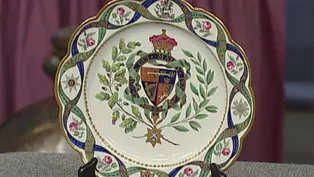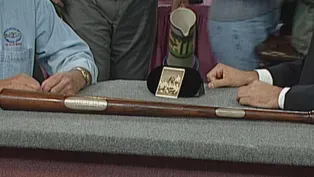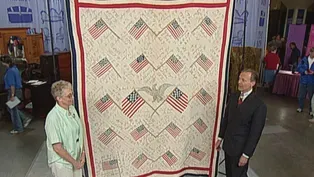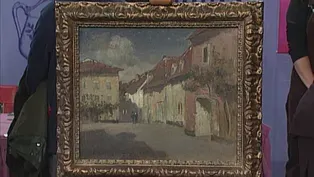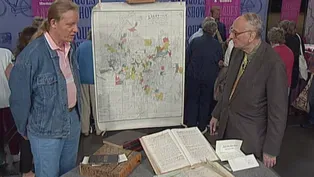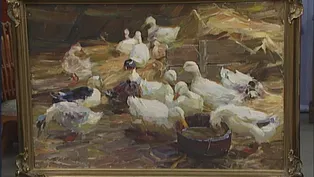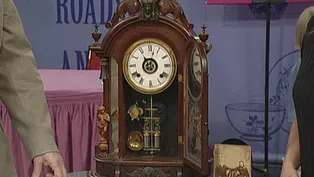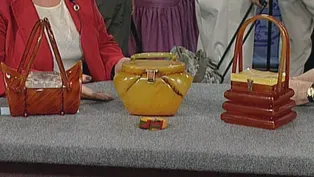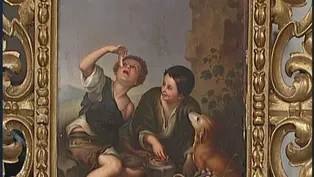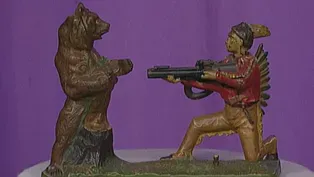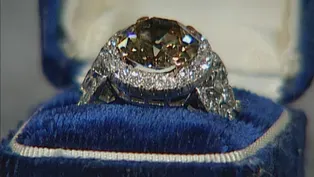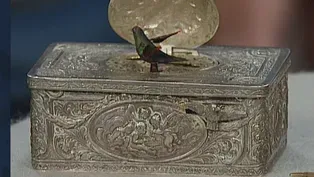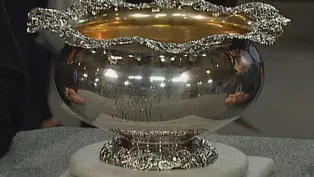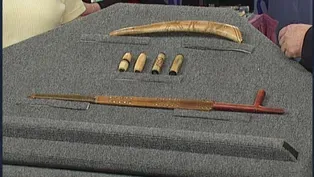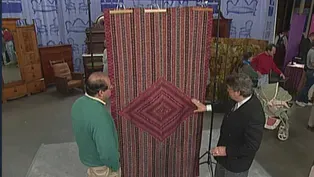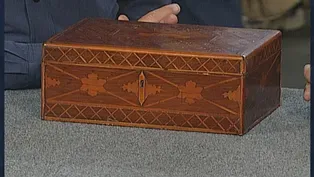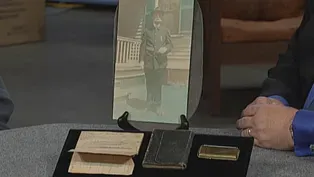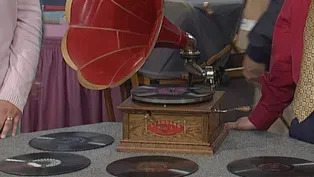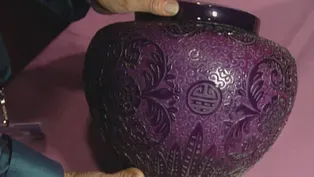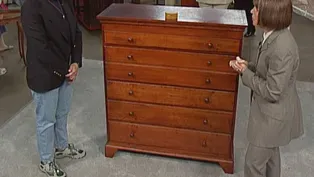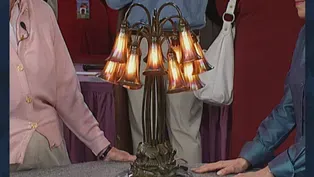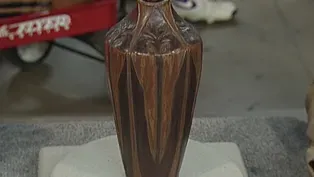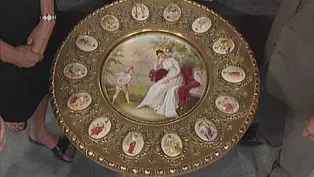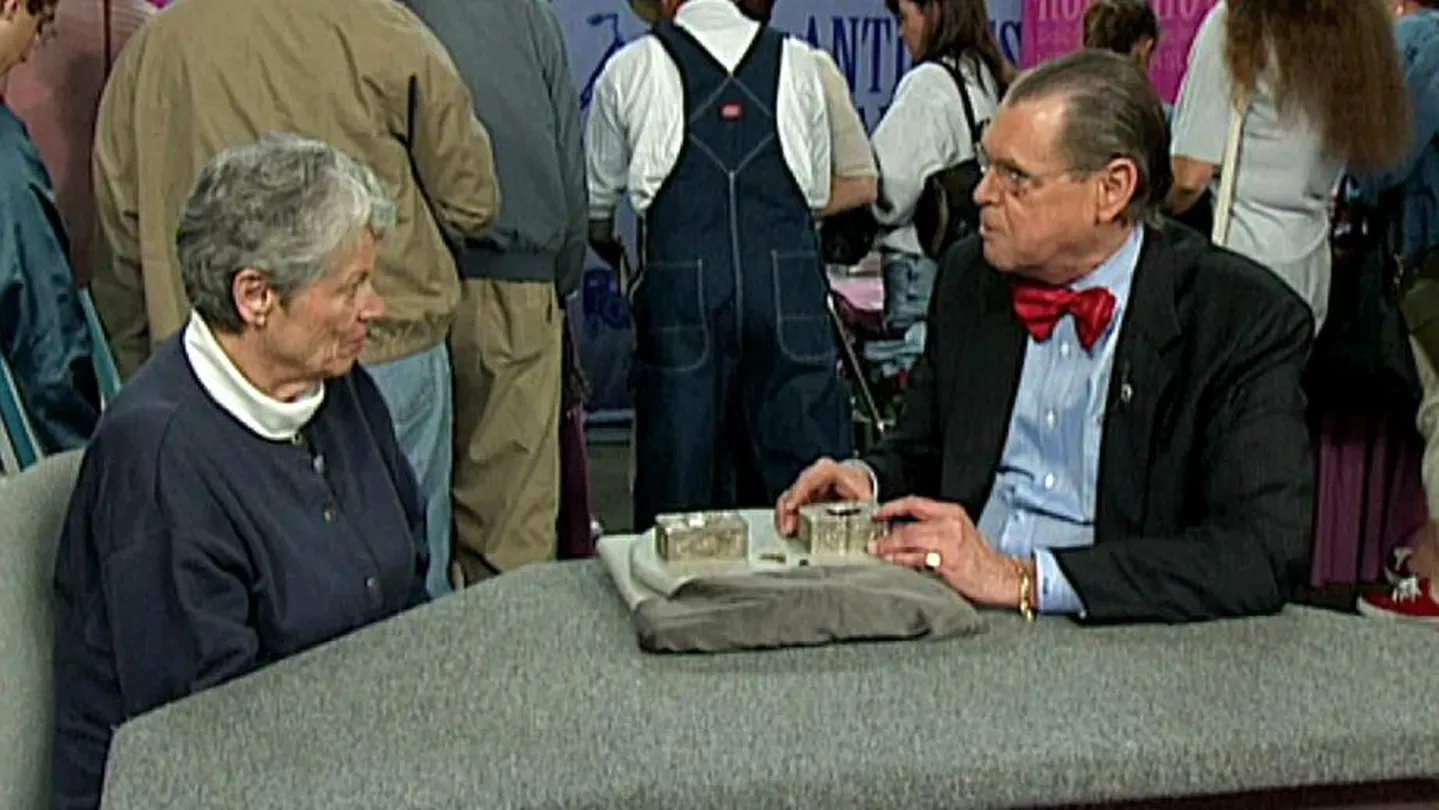

Vintage Denver
Season 19 Episode 27 | 53m 3sVideo has Closed Captions
Uncover changes in values from 15 years ago, including an appraisal that doubles in value.
Uncover changes in the value of appraisals from 15 years ago. Highlights include a Bakelite collection, a 19th C. Tabor mining archive, and some Jessie Willcox Smith paintings. See which item more than doubles its original valuation.
Problems with Closed Captions? Closed Captioning Feedback
Problems with Closed Captions? Closed Captioning Feedback
Funding for ANTIQUES ROADSHOW is provided by Ancestry and American Cruise Lines. Additional funding is provided by public television viewers.

Vintage Denver
Season 19 Episode 27 | 53m 3sVideo has Closed Captions
Uncover changes in the value of appraisals from 15 years ago. Highlights include a Bakelite collection, a 19th C. Tabor mining archive, and some Jessie Willcox Smith paintings. See which item more than doubles its original valuation.
Problems with Closed Captions? Closed Captioning Feedback
How to Watch Antiques Roadshow
Antiques Roadshow is available to stream on pbs.org and the free PBS App, available on iPhone, Apple TV, Android TV, Android smartphones, Amazon Fire TV, Amazon Fire Tablet, Roku, Samsung Smart TV, and Vizio.
Buy Now

ANTIQUES ROADSHOW 2025 Tour!
Enter now for a chance to win free tickets to ANTIQUES ROADSHOW's 2025 Tour! Plus, see which cities we're headed to!Providing Support for PBS.org
Learn Moreabout PBS online sponsorshipNo way!
This has an old tag on it that says "$25."
Yes.
You think that would be a fair appraisal?
Absolutely not.
Oh, my goodness, that's great!
That's very good for a five-dollar investment.
You own a plate which once belonged to a member of the English royal family.
Oh!
That's very nice.
(laughs) WALBERG: Roadshow touched down in the mile-high city at the dawn of a new age-- that's right, the year 2000.
We discovered many turn- of-the-20th-century treasures, including this playful cast-iron bank.
Let's see if the value of this thrifty toy and other finds have gone up, down, or stayed the same in this fresh look at Denver.
When we think about antiques, we normally don't think about plastics.
I know.
And that's what you brought us here, Bakelite, which is an early form of plastic, a phenol formaldehyde.
How did you get these?
I'm a collector, and I just love purses.
I have more at home, but I think these are three of the best.
I love Art Deco stuff.
Well, this is the quintessential Art Deco look.
In 1908, a man called L.H.
Baekeland got the patent for Bakelite, and that's where we get the name Bakelite from.
And here we have three examples of terrific purses.
These have become very collectible over the past couple years.
We've seen an increased value in radios and other Bakelite items.
Sometimes they're marked like this first one, which is by Llewellyn.
Sometimes they're not.
Sometimes they're just great style, like this one.
But purses like this run for between about $500 to about $1,000, to about $1,500.
Yes!
So you've really done just a great job.
But tell me a little bit about how you got this bracelet.
Mrs. Bart lived just down the block from my parents, and she was elderly, and my parents would do the lawn, and the light would go out and my dad would go down and fix it, and they just became very good friends and took good care of her.
She passed away.
People from back east came and took most everything in the house.
My mom went down to clean, and the people that were there said "Take this, throw it away, do whatever you want with it, we don't it."
So Mom said, "You know what, take it."
So she did, and then she gave it to me.
It's very classic Bakelite design.
It's called the Philadelphia bracelet.
And I'm going to say, conservatively, it's worth between $6,000 and $8,000.
No way!
And I've asked a couple of other experts here, and we feel it could be even worth a little bit more than that.
Oh, my God!
(laughing) Yay!
This is so cool!
Oh, thank you so much!
Am I allowed to hug you, or is that not okay?
Oh, thank you so much, oh, my gosh!
(laughing) Okay, that is so cool, oh, my gosh!
Oh, thank you so much!
WOMAN: This table has been in my parents' living room for 25 years, and they purchased it from a friend, who had collected antiques for quite a few years.
They paid $1,000 for it.
It's a very good-looking table.
It's got a combination of material that you find very commonly in and around the late 1800s.
It's porcelain-mounted and giltwood, and this giltwood, when you look down here, this very elaborate cabriole leg that's carved with foliage is what we call Rococo Revival.
Now, this is the sort of piece that someone probably would have picked up on a tour, perhaps, through Austria.
And I'll show you why.
All right.
I'm going to lift the top off, and what you have are these marvelous painted rondelles.
These are all Neo-Classical scenes.
And these are all hand-painted, and that's important, because oftentimes, what you find in porcelain plaques from this time period are transfer-printed, which are like decal-decorated, but these are all hand-painted.
And the center one, which is signed Ulmer, is just very well done.
Probably done by one of the factory's better painters.
And if you look on the back, it has just what we would expect to find.
This is a title in German, which is ein Traum, which means "a dream."
Oh, okay.
And this is what they call a beehive mark, but it's actually the shield off of the Habsburg crest.
And up here, we have Austria, which is an export mark, which means it was manufactured around 1892.
So it's probably around 1895.
All right.
And you can see, when you go back, "a dream," which is really nice.
Put it back down here.
Now, I imagine you guys don't use this for a plant stand at home.
No, we don't.
At auction, I would expect to get around $8,000 to $12,000 for it.
Good, good, terrific.
A really beautiful piece, and beautifully painted.
Well, that's good to know.
What we have is a box, one apparently of three, that was built by Dr. Samuel Mudd, who was one of the indicted co-conspirators in the assassination of Abraham Lincoln.
And of course everybody who's read American history, or should have read American history, knows that Mudd was indicted for setting the broken leg of John Wilkes Booth on the night of April 14, 1865, as Booth was trying to get out of Washington.
How did you come by this box?
And I'm going to lift it up so people can see the lid a little bit here.
This was a gift to me, almost 20 years ago now, by a very dear friend who had owned it for, apparently, about 50 years.
As she was getting late in years, she said she had to dispose of her property, knew that I was a Lincoln fanatic, and wished to give it to me if I wanted it.
The outside is this beautiful marquetry, but what's really neat, of course, is when you open it up and you see this marvelous wreath of seaweed with the inscription that was apparently written by W. Butler Bach of the 5th Artillery U.S. Army, who presumably was a guard at Fort Jefferson.
Yes.
Saying that it was made by Dr. Samuel Mudd in prison at Fort Jefferson in the Dry Tortugas, which of course are about 65 miles from Key West, Florida, where Mudd was sent when he was imprisoned.
And it was apparently made from driftwood that he picked up on the beach.
Carl Sandberg, in his book The Lincoln Collector, describes one of the other three boxes, one that was made for Mudd's own daughter.
And Dr. Richard Mudd, who has led the fight for his grandfather's exoneration, has come down two or three times to look at it, and he's acknowledged that, "Wow, this is one of the ones my grandfather made."
If I were to put this in an auction, I would estimate its value at somewhere between $10,000 to $15,000 or $15,000 to $20,000.
Hm!
Wow, that is impressive.
I must tell you that it's among the possessions I would least like to dispose of.
WOMAN: My mother gave it to me about ten years ago.
It's been in the family for probably about 80 years or so.
Well, it dates from around 1900.
Penny banks were a very popular toy in the late-19th century, and also became very popular among collectors in the 20th century.
I find them very attractive because they have this wonderful sculptural quality, that the cast iron has a real dimensional quality and great paint.
Of course, the kids of the 19th century found them exciting because of the action.
You pull back this...
But did you know that you could put a cap in here?
No, I didn't know that.
See, there's a little slot right here where the kid could put a cap, and so that not only would you... after you shoot the penny and get the action, you would also have a nice little explosion.
Oh!
So a kid got a lot of bang for his penny.
That's interesting.
This is a very nice bank, made by J.
& E. Stevens in Cromwell, Connecticut, started in around the 1890s, but what makes this bank a little special is the fact that it has the original feathers.
Mm.
So many banks have a fragile point that you always look at to see if it's been repaired, and on the Indian and bear bank, you always look at these feathers.
It's very fragile.
It's almost always replaced.
Oh.
So that's the first thing I looked at, and I was really excited to see that you have a really fine example.
And I would say on today's market, this bank, in this condition, with the original feathers and the quality of the paint, would be worth at least $4,000 to $5,000.
Oh, wow.
That's wonderful.
Keep it out of direct sun.
Okay.
Don't let that paint color fade, and don't try and clean it.
It's clean enough.
Okay.
WOMAN: My grandfather, who died before I was born, bought it on the street in New York.
Bought it, I heard, from, uh, a refugee, somebody right after the war, and brought it to my grandmother, told my grandmother that it was a yellow diamond or a canary diamond... Uh-huh.
And my grandmother, when she gave it to me a few years ago, said that she had never had it appraised.
She didn't know if it was in fact a diamond.
She just really liked it and she wore it often.
And have you ever worn it?
No, it's... it's not quite me, but... but I like it, I like to look at it in the box.
Okay, it's a wonderful diamond.
The mounting was made around 1920, but let's talk about the diamond first.
It's approximately six carats.
It would be classified as a yellowish-brown diamond, more commonly known as a cognac-colored diamond.
Okay.
Having a little bit more brown than yellow, therefore not being a canary diamond.
A canary diamond would truly be the color of the canary bird, although still a desirable, pretty ring.
The mounting itself is Art Deco.
We have in here some triangular-cut diamonds, kite-shaped diamonds, and half-moon diamonds, which makes it really very interesting.
They're very typical stones cut in the Art Deco time period.
And it's surrounded by pavé-set diamonds right around the center diamond itself, "pavé-set diamond" meaning set very close together.
One time I went into a jewelry store and they said, "Well, this is yellow.
Nobody wants a yellow diamond."
I was so embarrassed.
Well, in the market today, this piece would bring approximately between $12,000 and $15,000.
Wow, that's great to know.
You should take it out and wear it at parties every once in a while.
Well, you know, I think of her and I never knew my grandfather, but it's a great story, so...
Thank you, thanks very much.
You're welcome.
MAN: My cousin from England sent it to me and she had got it from her mother and her mother got it as a gift from the artist.
APPRAISER: And besides the painting, you brought in a letter signed by the artist and from the artist dedicating the painting to your great-aunt, or...?
Great-aunt, uh-huh.
She was a painter, and she exhibited in France and he liked her painting and said, "I'll trade you one of mine for this one of yours," and he did, and the letter is saying he was sending it over.
The letter is dated 1905 and is discussing the gift to her of this painting that he did in the south of France.
The artist is Fritz Thaulow.
He's a Norwegian painter, probably one of the best-known of the Norwegian artists of the late 19th century.
He was a great friend of Monet's and Rodin's, a great admirer of the French realist painter Bastien-Lepage and also of Whistler.
This is done in 1905, and the artist dies in 1906.
In the lower left-hand side, you have the inscription "To Emily Lang"-- I gather your great-aunt-- so that's kind of interesting as well that it was dedicated to her personally because at this time in his career, he was very well known.
He was probably the best of the Norwegian artists other than Munch.
This painting has a lot of the quality of Whistler, this sort of tonality, the evening light in this small village in the south of France.
It's in its original frame.
It seems to be in good condition.
It hasn't been damaged.
And I would think that the painting would be about $18,000, maybe $20,000 today.
This is a nice little souvenir from your aunt.
Wow, wow!
I'm going to call her tonight and tell her.
She's still in England?
She's still in England.
She's a sharp lady still, so she'll be excited.
MAN: I bought it from a friend of mine in 1974.
He had bought it in 1957 at a storage outfit auction, and it was placed in storage in 1930.
When he told me about what he had, I went and took a look at it and there were nine pieces in all, and I bought the whole group.
What did you pay for them?
I paid $1,000 for the entire group.
Okay, that's good.
Now, I understand you...
I think you figured out these are Plains Indian, this particular piece.
Right, Plains Indian, but I don't know what tribe or group they came from, nor do I know the age.
They're called saddle throws or saddlebags, and it's a really classic type of object for the Plains Indians-- a panel of bold beadwork, which several of the groups did.
The Cheyenne did it, the Arapaho did it, and the Lakota.
You can tell these are Cheyenne by the way they built up the steps on the little pyramids.
Oh, okay.
The Lakota would have used half of that space for their checks, as would the Arapaho, but the Cheyenne used the whole row of beads to build these steps up.
Okay.
The white background is very typical of Cheyenne and Lakota; the long fringe, very typical for the period.
These are from about the 1870s.
This was a period when they had their last freedom, really.
In another five years after these were made, they were all put on the reservations, so from that perspective, too, it's a great example.
This triangle is also a very typical Cheyenne characteristic, as is the yellow ocher rubbed in.
So you've got a classic pair of Cheyenne saddlebags, very desirable on today's market.
They're very sought after.
I would conservatively estimate them at $10,000 to $15,000.
Oh, my.
So that's a beautiful pair, and Cheyenne's very sought after.
Great.
My father-in-law had bought it around 1928, in Chicago.
APPRAISER: And did you use it over the years?
We used it up until around 1960, and then since then, it's been in storage.
Was using it up till around 1960, did that have anything to do with having children in the house?
Yes, we had children and dogs at that time, mm-hmm.
Well, I'm very glad that you held on to it and that you were able to keep it in such great condition because this is a Tiffany Studios 12-Light Lily Lamp.
Sometimes we call it the "Pond Lily."
In fact, I believe that's what Tiffany referred to it in his inventory lists when he was selling these lamps.
And the reason why he said Pond Lily, you can see the little lily pads down here that cluster around the stems leading up to these beautiful glass shades which are resembling flowers.
This is such a great patina-- the finish over the bronze that this base is made out of.
The finish is an original finish, and what was very refreshing for me today was to see an original finish because so many of them get stripped over the years, and then people try to fix them and it just never looks like the original.
But this is original.
How old would this be, then?
Well, they were making this from 1902 probably right up until the 1920s.
I would say that yours is more on the earlier end of things because this was the kind of work that was being done from 1902 probably to about 1915.
The shades, which are the most valuable part of the lamp, are all intact.
What's happened with lily lamps is that it's been a very movable feast.
The prices have sort of gone up and down and shot way up, but over the past couple years, I think they've reached a new plateau which people are very comfortable at buying them at, and I would value this lamp today between $30,000 and $40,000.
Amazing.
WOMAN: It's a Bierstadt, and my husband and I are both very familiar with Bierstadt, and we love his works.
We were at an auction last fall and purchased it there, and then this winter went over to the public library and just did some research to find out a little more about it-- the time frames, etc.
The original is supposed to be hanging in the Metropolitan Museum in New York.
You're right, absolutely.
It's a wonderful print, and actually, it's more than just an American landscape.
It's one of the great American landscapes.
The artist is recognized here.
James Smillie, the engraver, is there.
And it says "Albert Bierstadt, 1863."
That's when the original painting was done.
But the print was done in 1866, which is on the copyright date here on this line underneath, and that's one year after the end of the Civil War.
So of course the West was opening up.
And we've got this wonderful composition where of course they were fascinated with waterfalls, and the light and shadow and the focus is right on that waterfall.
It's perfect for the engraver's art because you have varieties of intensity of engraving, and perspective is done by the age-old method of very light engraving on the background part.
And then as you get heavier engraving, it's the foreground.
And of course it's just a wonderful panorama.
You have this wonderful original frame as well.
It's just a gorgeous Victorian frame, the kind of thing that would have hung in a big parlor with 18-foot ceilings.
What did you pay for this?
We paid just under $500.
Well, you got a very good buy on that because at this point and in this condition, it's worth about $4,000.
Oh, that's good news.
If this was cleaned...
There's some foxing marks in here, there's some browning around the edges.
This print in very good condition sells for about $6,500 to $7,500.
Ooh, that's wonderful.
So it's well worth it to put a few hundred dollars into restoration.
It's a wonderful item of American history and work that you're seeing here.
Well, thank you, we love it.
You brought some things that belonged to your great- great-grandfather.
Tell me what you know.
Well, he was a soldier in Custer's Seventh Cavalry for about five years, I believe.
He was a private.
He was involved in only one major battle-- Battle of Washita Creek, where Black Kettle was killed along with about a hundred other, uh, Cheyenne and Arapaho.
Your great-great-grandfather, depending on how you look at it, was either in the right place or the wrong place at the right time.
Sure, yeah.
He kept a diary, and the diary is what it's all about because it records one of the more controversial incidents in the history of the American frontier West-- the Black Kettle Massacre, as it's called today.
It occurred on the Washita River in western Oklahoma.
The diary is a day-by-day account up to the battle and after the battle.
He says on Friday night, November 26, 1868, they rode up to the Cheyenne camp, which was a group of Cheyenne and Arapahos camped together, led by Black Kettle.
Black Kettle had already been attacked at Sand Creek, here in Colorado, by Chivington.
He fled to western Oklahoma and Custer followed him.
Your great-great-grandfather talks about sitting in the saddle all night, waiting for the attack.
In the snow.
In the snow in November.
It was a bad winter in 1868.
They attacked the camp at first light.
Not at sunrise, but just as it was light enough to see, they attacked the camp.
Your great-great- grandfather says between 150 and 250 Indians were killed.
I believe his numbers are probably pretty close to correct.
Modern accounts say fewer.
Women, children, warriors, everyone was killed.
Right.
And what was left were the burnt teepee poles standing on the prairie.
He also accounts two weeks later that Custer and Sheridan went back to the Washita battle site to look for troopers.
The troopers they were looking for were a group of soldiers who were led away from the battle site by a group of Arapaho warriors up a dry creek bed, or a coulee.
They got into the coulee and were totally overcome, and they killed them all.
And it mentions that in the diary that they found the bodies of the troopers.
Right, right.
The diary tells the weather day by day, where they were camped, what forts they went to, the ranches they were at.
This is a very important piece of American history.
Part of the group of things are these two diaries, this photograph that was taken of him much later in life, and this match case.
And the match case is scratched into the front "T.C.
Custer."
T.C.
Custer was George Custer's brother, Thomas Custer.
Value?
It's very hard to say.
Conservatively-- conservatively-- $7,000 to $10,000 for the material.
With the right people in the room on a good day, the sky's the limit.
You need to keep all the papers and all the documents together because they mention the friendship between Tom Custer and your great-great-grandfather.
Right.
And that helps verify this, which would greatly increase the value.
MAN: This bat is my great- great-grandfather's.
He played on a team in New London called the Pequots, and my mother, who's just turned 90, told me yesterday that somewhere in all the different trunks, there are newspaper articles about the team and their victories and who they played and how many hits and so on, and this is all back in the late 1800s.
And the gentleman holding the bat is my great-great- grandfather.
He was the pitcher, and their names are also inscribed on it so we know who all the team members were.
And of course, your great-great-grandfather is also holding this actual bat in the photograph.
That's correct.
And, uh, this bat is from 1866.
It's called a trophy bat.
These were given to the champions of the amateur baseball teams of the era.
This was when baseball was truly a game and people played for reputation, and the championship was... really, that was the heart and soul of it all, and this was what was awarded.
Your great-great-grandfather must have been a very important person on the team; he was awarded the bat.
It says right here it's a champion bat, New London County, New London, Connecticut.
"Presented by the Young Men's Association of Norwich."
It's composed of rosewood, which was a very expensive wood.
It was imported, and, uh, obviously a cherished memento.
I'd like you to tell me a little bit about the inscription on the back.
It says, "To Miss Addie"... who would be my great-great-grandmother.
"A memento of victory.
The Pequots versus the Chesters."
So in other words, your great-great-grandfather gave this bat-- probably his most cherished possession-- to your great-great- grandmother while he was courting her.
I believe that's correct.
It's fantastic.
It's phenomenal.
I love it!
I wish I had something like that in my family.
Um, in the memorabilia market right now, a bat like this is probably worth around $5,000 to $6,000.
Whoo!
As a family heirloom, absolutely priceless.
That's correct.
It's just amazing.
I really appreciate it.
This is Leadville-- the town of Leadville-- but the rest of the map is showing the mining claims that were established in Leadville.
This map is actually from 1901.
It shows mines that produced hundreds of millions of dollars' worth of precious metals over a 50-, 60-year period.
One of the most famous names in Leadville history is Tabor.
Yes.
And you have here a lot of papers from the Chrysolite Mine which belonged to William Tabor.
Well, my father was a mining engineer in Leadville, and he had an associate who bought the Chrysolite Mine after Horace Tabor had owned it.
Mr. Cliff, the one that bought the papers and the mine, didn't have any descendants, and my father inherited them.
I see.
And I inherited them.
I noticed here that we have the incorporation papers, which were signed in 1879.
There's the legal seal, and there's William H. Tabor's signature on the papers.
Then we have, uh, a check which is endorsed by Tabor on the back.
Yes.
This is from the records of the mine.
Tell me about some of the subjects that are covered in this.
A lot of the things in this ledger book were the day-to-day expenses, things that went on with the mines, and we even have some pages here about the miners that died in the mines and how they died.
So it deals in personnel.
It gives the social history of the times of this great mining district.
It talks about uprisings they had at the mines and buying guns to keep the miners from rioting and that sort of thing.
So we have a wonderful piece of Colorado history here-- a very large piece.
It's thousands of documents.
Thousands of documents, yes.
Right.
So I would say that if this material was offered at auction, because of its great depth and extreme size and its very fine condition-- we have more here that we haven't even shown-- I would say that it's worth $40,000 to $60,000 at auction.
Oh, wow.
Yeah, it's a treasure of another kind.
Yes.
Thank you.
Betty, when you brought this quilt in today, I thought to myself, "I've seen a lot of crazy quilts and a lot of regular woven quilts."
When you started to take this out of the bag, I realized what a great impact it had with all the stars and all the names from the Civil War, and then you pointed out this one over here.
Would you like to tell me who he is?
That's my great-grandfather.
And his name is...?
Robert Weaver, Illinois Volunteer Infantry, Company D. This has always been in your family, then?
Yes.
Well, it seems that what the... A group of women have gotten together and done this in 1896 as a commemorative, or I'll say a memorial, quilt.
And you and I have been discussing it, and there's a possibility that they know all these people and their different regiments that we're seeing throughout this quilt that they've very carefully worked out the names in embroidery, and then the women have done a beautiful job of quilting it.
And you just told me you've never seen it hanging, have you?
No, I haven't.
It's very impressive, isn't it?
Yes, it is.
It hasn't faded and it's in wonderful condition.
And then down at the bottom, the women have actually said "Made by U.B.
Ladies Aid, Maize, Kansas" so it is local, and it's dated 1896.
I would think conservatively, at auction, it would be valued between $6,000 and $10,000.
Oh, my goodness.
(chuckles) I bought the painting at an auction house in Denver 30 years ago.
And I liked it because I like animals.
And how much did you pay for this painting?
$50.
And it was under glass, so after a while, I talked to people.
They said, "Remove the glass because oil has to breathe."
So I did that, and the lady said "You have a very nice painting."
And it's a painter that painted mostly ducks.
And I thought "Well, you know, one day, maybe this painting will be worth something."
Well, it is by Alexander Koester, who was a German artist from the turn of the century.
He was born in 1864 to 1932, and he did.
Even though he painted a variety of subjects-- he painted portraits and he painted landscapes-- he specialized in ducks.
There were some European painters-- and American painters, too-- who will specialize in, like, cattle or chicken.
Koester specialized in ducks, and they are his trademark.
As a matter of fact, his nickname was "Enten," which means... Oh, Enten, yeah, duck, yeah.
Duck, exactly.
And this piece is probably a later work in his career.
Probably painted... my guess is around 1920.
It's very bright and impressionistic.
Very broadly painted.
It is somewhat loosely painted.
That's another reason why I think it's probably a later work.
Some of the ducks here aren't quite finished but still, you have a wonderful bravura brushwork, especially up in through here in the hay and the barnyard, and it's signed down here, "Alexander Koester."
And it's interesting that you told me that it was under glass because the painting is in wonderful condition.
The back of the painting is open so the canvas was, in fact, able to breathe, but the glass kept it perfectly clean and in wonderful condition.
Now, I would appraise this painting-- if it were to come onto the market today-- conservatively at $50,000 to $70,000.
Oh, really?
Some of his earlier works can bring a little bit more, but this is a perfectly beautiful painting and I think that you made a very good investment.
Oh, really?
Oh, that would be marvelous.
Yeah, I can't believe this.
I love this painting, I really do.
WOMAN: I found it at a yard sale.
APPRAISER: And how much did you pay for it?
I paid five dollars.
And you've enjoyed it?
Has it been hanging on the wall?
No, actually, I kind of put it away because the frame was kind of loose from the, uh, picture.
It's a painting taken from an Italian original.
The Italian original would have been done in the 18th century on canvas, and this is actually done on porcelain, and it was done in Germany just about the turn of the century, about 1900, and these boys are eating fruit, and it's actually very popular.
We do find this particular subject in a number of different sizes done by a number of different artists in the Berlin area, predominantly from the KPM Manufacturing Company.
It's really, really quite well done as we look at the workmanship.
I want to turn it over and show you the back, if I may.
There are some identifying marks which certainly do help date it as well as tell us exactly what region it was produced in.
In the center here, we have an impressed eagle mark, and that is actually a symbol that was used by a number of different manufacturers, but they were all done within and around the general area of Berlin.
So we certainly do know that this is a Berlin porcelain plaque.
Is that right?
There's also an additional paper label here, which-- let's turn it right side up-- was a retailer label, which is also always nice to have.
Very often, they've disintegrated.
It just gives a little bit more integrity to it that this label was on there from the very start.
My goodness.
Well, it's very, very competitive at auction.
People love plaques like this in very appealing subjects.
At auction today, I would expect would sell between $2,500 and $3,500.
Oh, my goodness.
That's great.
That's very good for a five-dollar investment.
Yes, yes, it is.
WOMAN: They are two silver boxes.
They're not music boxes, they're bird boxes.
When you pull a switch, a little bird comes out and sings.
One was from my mother, and I remember it in the house when I was a child, and the other was from an old aunt who left it to me when she died.
These are German bird boxes which really, in effect, are also music boxes.
They're beautifully done in German silver, which is not quite the quality of our sterling, but it is German silver.
A repoussé and floral chase decoration-- very fine quality.
Uh, this particular box here is late 19th-century, made in Germany.
Uh, this box is a little earlier.
Would be probably second quarter of the 19th century.
Again, very fine chased and repoussé decoration with floral panels and so forth.
And then, of course, to wind them up, we have this nice little brass key in the form of a bird.
They sound wonderful.
I'll just start them up now.
You press that little bird, and he comes up.
(chirping) And let's give him a companion, and they're singing to us.
This one, the wings are also functioning.
This one, the wings don't work.
Oop, he got a little tired and decided to go home.
And so did he.
These are very popular today.
In a well-advertised auction, this box would be estimated somewhere between $2,500 and $3,500, and this box, between $3,000 and $4,000.
Oh, my!
Thank you very much for bringing them to the Roadshow.
Thank you.
That is amazing.
WOMAN: My husband bought it for me.
It was at an antique shop here in Denver 20 years ago.
APPRAISER: Do you mind telling me what you paid for it or what your husband paid for it?
He bought three pieces together, but I figured about $300.
Okay, well, you own a plate which once belonged to a member of the English royal family.
It bears the arms that tell us it's from a famous porcelain service made in Worcester, in England, for a gentleman who was then the Duke of Clarence, who went on to become king of England, William IV.
He became king in 1830.
But much earlier in his history, he had this service made.
It bears a mark painted in blue here, which has a crescent, which is the mark that Worcester has used since it began in the 1750s and, in fact, still uses that mark because the company still exists as Royal Worcester.
Above it, it says "Flight," which was the name of the owner of the factory at the time, and a little crown, which was put there because of a royal visit by the Duke of Clarence in 1788.
They put the crown on right afterwards.
He ordered the service and it was made in the following year, 1789.
So it's an early piece and an important piece of English porcelain, and bits of this service turn up all over the world, and porcelain collectors love to see them.
Now, if your husband paid $300 for it he did very, very well, because today, we're never quite sure what they're going to sell for.
It depends on how much somebody wants one.
But I would estimate that at auction, it could bring as much as $8,000 or even $10,000... Oh, really!
For this one plate, really.
Oh, that's very nice.
MAN: This was collected by my grandfather.
He got it in Mexico back in the '20s.
He was a geologist.
He came over from Holland with Royal Dutch/Shell.
He was doing exploration in the Southwest and Louisiana and Mexico, so he picked this up.
APPRAISER: Well, let me tell you a little bit about the weaving.
First of all, the history of the Saltillo.
Saltillo is a city in northern Mexico, and it was a weaving center, and the Saltillos were known for the greatest flatware weavings in this hemisphere, or among the greatest.
In the Saltillo weaving, there's basically two types.
There's the diamond type and then there's the circular type.
Now, these are wearing apparel, and they're split here, and then it would be draped over the body.
It looked pretty flashy on horseback.
I can imagine.
And they greatly influenced the Navajo weaving.
I didn't know that.
Now, the top was cut, and then down on the bottom, it was cut.
Right.
It's great that it has wear, but this does affect the value.
Now, what do people want to see in a Saltillo weaving?
They love this deep red color.
The dye comes from a beetle and it's called cochineal, and it's this wonderful purpley-red color.
So we know this thing is 1850 to 1875 because the diamonds tend to get larger and they come over and they touch the edge.
The earlier ones, generally speaking, the circles are smaller, the diamonds are smaller.
I was wondering about the age.
So this is 1850 to 1875.
As is, this is a $6,000 to $8,000 weaving.
Okay.
Now, that's good news.
If the thing were mint, you'd be talking $10,000 to $15,000.
Thank you very much, I appreciate that.
WOMAN: My mother-in-law has this in her home.
It's my husband's grandfather's.
He came to this country from Germany as a small boy and he bought this for himself, a farmer on the eastern plains of Colorado.
He bought this for himself as a young man probably about the age of 20.
We're guessing somewhere between 1900 and 1910 based on what other relatives recall.
We use it frequently, and my mother-in-law sure does, and we enjoy it, but we're very careful with it.
Good-- well, it shows.
You're right about that, it's about 1910.
It's called the Standard.
The machine was actually made by the Columbia Phonograph Company, and it was sold by a Chicago company.
Now, what's fun about this machine, unlike most phonographs, is you see the spindle hole?
You see how big it is?
Yes.
It's twice the size of normal record spindle holes, be it 78, 45 or 33.
They had a standard size.
But this company was very smart.
They bought the machines from Columbia at wholesale-- they weren't expensive machines to make-- and then they sold them by mail order very cheap.
Yes.
So a farm boy, young man could buy one, have his own record player, own phonograph, but then he was stuck.
He couldn't buy any other records but Standard records because it wouldn't go on the spindle.
Is that right?
It was a Chicago...
I don't want to say a Chicago scam... (laughing) So what do we have?
We have a beautiful- condition machine.
The condition of the horn is lovely.
The red paint is great, not a lot of scratches.
The case is good, the arm is good.
It works beautifully and it sounds pretty good.
It could use a little bit of work on the sound box here and it would sound even better.
This gasket here is dried up.
It's 80, 90 years old, it's dried up, that's normal.
And they're not rare machines.
Collectors aren't that fond of them because of the big spindle hole, but at auction, you tend to find that they make between $400 and $600 in very good condition.
And before we go, should we have a spin?
Sure.
Okay.
Thank you.
Wind it up there... turn it on here... And away we go.
(marching band music playing scratchily) There was a gentleman who owned the first trading post at Manitou Springs, Colorado ,by the name of Mr. Ellison.
His wife's father was one of the first archaeologists into Mesa Verde, and they owned the Manitou Springs Gallery for 40 or 50 years.
He was a great collector of antiquities and a great patron of the Indian Native Americans.
APPRAISER: And we have some documentation that suggests that a lot of this material was collected by the same family early on in the 1930s... or as late as the 1930s.
The object at the bottom is a peace pipe, a man's pipe.
And what's particularly beautiful about this pipe outside of the brass wrapping and the brass tacks is this is one of the most slenderly beautiful bowls I've seen.
It has this very delicate line engraving of a human head, probably a man's head.
And that's quite unusual for a pipe like this and, to my eye, very beautiful.
The other things in the middle generally are fairly mundane objects.
They're gaming pieces for a hand game played by the Native Americans.
These are the most beautiful I've ever seen of that type with the engraving, the painting, and the copper inlays.
But the thing that stopped everybody in their tracks at my table when you pulled it out was this horse quirt.
Yes.
As you know, the tag calls this a horse whip where we usually call them quirts, and they were used to control the horse.
This would have originally had a long leather thong.
It also would have had a handle here that he could loop it through his wrists so as he was riding, it wouldn't fall off.
And the handle would have almost certainly been decorated perhaps with quillwork or beadwork.
Frequently, the long leather thong would have brass tacks.
And it's made from...
This is made from elk antler.
And not any elk antler, but a huge rack from an elk.
This is a very large antler.
This could be any Plains Indian, then.
It's very hard.
Most of this, as we know from the documentation, came from Pawnee, Oklahoma.
This is likely not Pawnee.
This is Northern Plains.
Cheyenne, or... Cheyenne, Arapaho, perhaps Sioux.
And this is unequivocally the greatest quirt I have ever seen in my life.
It's beautiful.
Inside any museum, outside of a museum, The quality of the engraving on this is phenomenal.
It's as good as the best ledger drawings we have ever seen.
This man's hunting a buffalo with a bow and arrow.
The buffalo tracks at the bottom are extraordinary.
I initially thought this was perhaps early 19th-century, but when we turn it over, we see a hunter shooting a buffalo with a handgun, which helps us date it to more the mid-19th century.
In terms of value, the pipe at the bottom, you're probably looking at $4,000 to $5,000.
The gaming pieces-- not very valuable, but very beautiful-- perhaps $1,200, $1,500.
The quirt-- boy, what a quirt-- has an old tag on it that says $25.
Yes.
You think that would be a fair appraisal?
Absolutely not.
Well, very safely, this quirt is worth $30,000 to $35,000.
Congratulations.
Thank you.
It is an extraordinary work of art.
It's certainly cherished.
One of the great line-engraved objects I have ever seen.
WOMAN: I've had it for about three years and I went to this sale.
I went in about an hour after it had opened, and there this sat, and so I bought it, and my husband couldn't believe me when I came back out and told him how much I'd paid for it.
Which was how much?
Ten dollars.
And so, then, Todd here collects Van Briggle and he's always wanted it.
You said your mom worked at the Van Briggle factory?
And my mother worked at Van Briggle.
About 50 years.
But we did not have one piece of Van Briggle.
You're a Van Briggle collector.
Why did you bring this piece instead of some of the other pieces you have at home?
Because of the glaze, and the detail in the pattern I thought was interesting enough to bring.
Well, it really is interesting.
Van Briggle is molded pottery.
You tend to see the forms over and over again, and in spite of this being a molded pot I can't say I've seen this form ever in the last 30 years.
What's also interesting is that while the design on the pot is molded, there's a fair amount of hand-tooling done to the piece.
If you look at the ridges on the outsides of this triangle and the modeling within the flower, that's all done by hand after the mold, which is typical of a particularly early piece of Van Briggle.
The hand modeling tapered off the later the pots got.
You can see the mark on the bottom of the pot, but you can't really see the dating on it because it's covered with glaze, which happens fairly often on Van Briggle, but I can tell you that you're right.
This is a rare glaze combination.
I've had it three other times.
I only know of...
This is the fourth one I know to exist.
If this was cleaned properly, because it's pretty dirty, I think that purple you see would have an iridescent or a nacreous luster to it.
The other three are all dated 1904, so this is a particularly early piece made while Van Briggle was still alive.
And aside from all that, I think it's absolutely beautiful.
This is really one of the prettiest pieces of Van Briggle I've seen.
The design is tight and crisp, the coloration is good, the form is good, and if I was selling this piece, believe it or not, I wouldn't take less than $15,000 for it.
What?
It's a really good piece of Van Briggle, yeah.
And not much is worth that kind of money.
So congratulations.
Well, thank you.
These are done by my great-great-aunt.
Who was...?
That was Jessie Willcox Smith.
Right, and you know a little bit about her.
Oh, I know she's very popular.
She did illustrations for Good Housekeeping magazine.
My parents have three paintings, and we have two of hers.
That's great.
Well, she is one of America's finest illustrators.
She was born around 1863, you probably already know that, and lived to 1935.
And she was doing things for magazines, she was an illustrator.
She illustrated for books and magazines, primarily.
Sort of like Norman Rockwell, but she was much before he was.
She was a trained artist.
She was actually trained in Philadelphia.
Yes.
Under Thomas Eakins, one of America's finest painters.
Came through that Pennsylvania academy.
What I found out that's interesting, she was a kindergarten teacher as well.
And that brings a lot to her paintings, because most of them focus on children and very wonderful, cute visions of children and childhood.
Right, although she never had children of her own.
Really?
She never married and never had children of her own.
She had some great illustrations, and you brought a couple in today.
One of the things you brought in is the book that this is for.
This is the book called The Princess and the Goblin.
Yes.
You can see it here, this is the illustration for the cover.
And this is another illustration back here for something later on in the book.
Right.
People who collect illustration art really go crazy for the covers.
And you have one here, and it's a beautiful cover, one of Jessie Willcox Smith's best pieces.
I would say at auction right now, the value of this would be about $30,000.
And this one, about $20,000.
This is a little bit darker.
But this is just quintessential Jessie Willcox Smith.
Right, good.
Thanks.
Thank you very much.
It's a silver punch bowl that was owned by the Hallett family, which was one of the very prominent early families when Colorado first became a state just prior to the turn of the century.
He was one of the founders of the Smuggler Mine in Aspen, which is the big silver mine up there which was, of course, what got Aspen going and turned it into what it is today.
Is there an inscription that you want to read, or can you read for us?
It says, "Mr. and Mrs. Hallett.
"Presented by the employees of the Smuggler Mining Company May 1st, 1901."
Okay, and do you have any idea where it was made?
Presumably the silver would come from the Smuggler Mine, but where it was made is a mystery.
Well, what's interesting is the very typical Art Nouveau decor from that time period.
You have the poppies and the scrolling foliage.
Inside, we have a gilt finish.
That would have protected the silver from any corrosive substances.
And we have Gorham Manufacturing Company as the maker.
Now, Gorham Manufacturing Company is based in Providence, Rhode Island, so probably they did mine the silver in Colorado, but at that time, the best silversmiths were back East, so they sent it back to have Gorham make it.
And at an auction, this would bring about $4,000 to $5,000.
Really?
Yes.
That's surprising.
Captioned by Media Access Group at WGBH access.wgbh.org
Appraisal: 1789 Duke of Clarence Plate
Video has Closed Captions
Clip: S19 Ep27 | 1m 55s | Appraisal: 1789 Duke of Clarence Plate , from Vintage Denver. (1m 55s)
Appraisal: 1866 Trophy Baseball Bat
Video has Closed Captions
Clip: S19 Ep27 | 2m 24s | Appraisal: 1866 Trophy Baseball Bat, from Vintage Denver. (2m 24s)
Appraisal: 1896 Civil War Memorial Quilt
Video has Closed Captions
Clip: S19 Ep27 | 1m 36s | Appraisal: 1896 Civil War Memorial Quilt, from Vintage Denver. (1m 36s)
Appraisal: 1905 Fritz Thaulow Painting
Video has Closed Captions
Clip: S19 Ep27 | 1m 50s | Appraisal: 1905 Fritz Thaulow Painting, from Vintage Denver. (1m 50s)
Appraisal: 19th-Century Tabor Mining Archive
Video has Closed Captions
Clip: S19 Ep27 | 2m 29s | Appraisal: 19th-Century Tabor Mining Archive, from Vintage Denver. (2m 29s)
Appraisal: Alexander Koester Oil, ca. 1920
Video has Closed Captions
Clip: S19 Ep27 | 2m 9s | Appraisal: Alexander Koester Oil, ca. 1920, from Vintage Denver. (2m 9s)
Appraisal: Ansonia Mantel Clock, ca. 1883
Video has Closed Captions
Clip: S19 Ep27 | 34s | Appraisal: Ansonia Mantel Clock, ca. 1883, from Vintage Denver. (34s)
Appraisal: Bakelite Purses & Bracelet
Video has Closed Captions
Clip: S19 Ep27 | 2m 29s | Appraisal: Bakelite Purses & Bracelet, from Vintage Denver. (2m 29s)
Appraisal: Berlin Porcelain Plaque, ca. 1900
Video has Closed Captions
Clip: S19 Ep27 | 2m 3s | Appraisal: Berlin Porcelain Plaque, ca. 1900, from Vintage Denver. (2m 3s)
Appraisal: Cast Iron Penny Bank, ca. 1900
Video has Closed Captions
Clip: S19 Ep27 | 2m | Appraisal: Cast Iron Penny Bank, ca. 1900, from Vintage Denver. (2m)
Appraisal: Cheyenne Saddle Bags, ca. 1870
Video has Closed Captions
Clip: S19 Ep27 | 2m 7s | Appraisal: Cheyenne Saddle Bags, ca. 1870, from Vintage Denver. (2m 7s)
Appraisal: Cognac Diamond Ring, ca. 1920
Video has Closed Captions
Clip: S19 Ep27 | 1m 54s | Appraisal: Cognac Diamond Ring, ca. 1920, from Vintage Denver. (1m 54s)
Appraisal: German Silver Music Boxes
Video has Closed Captions
Clip: S19 Ep27 | 2m 11s | Appraisal: German Silver Music Boxes , from Vintage Denver. (2m 11s)
Appraisal: Gorham Silver Punch Bowl, ca. 1901
Video has Closed Captions
Clip: S19 Ep27 | 1m 50s | Appraisal: Gorham Silver Punch Bowl, ca. 1901, from Vintage Denver. (1m 50s)
Appraisal: Jessie Willcox Smith Paintings
Video has Closed Captions
Clip: S19 Ep27 | 1m 55s | Appraisal: Jessie Willcox Smith Paintings, from Vintage Denver. (1m 55s)
Appraisal: Pipe, Gaming Pieces & Quilt
Video has Closed Captions
Clip: S19 Ep27 | 3m 25s | Appraisal: Pipe, Gaming Pieces & Quilt, from Vintage Denver. (3m 25s)
Appraisal: Saltillo Weaving, ca. 1860
Video has Closed Captions
Clip: S19 Ep27 | 2m 4s | Appraisal: Saltillo Weaving, ca. 1860, from Vintage Denver. (2m 4s)
Appraisal: Samuel Mudd Marquetry Box
Video has Closed Captions
Clip: S19 Ep27 | 2m 25s | Appraisal: Samuel Mudd Marquetry Box, from Vintage Denver. (2m 25s)
Appraisal: Soldier's Diary & Memorabilia
Video has Closed Captions
Clip: S19 Ep27 | 3m 42s | Appraisal: Soldier's Diary & Memorabilia, from Vintage Denver. (3m 42s)
Appraisal: Standard Phonograph & Records
Video has Closed Captions
Clip: S19 Ep27 | 2m 23s | Appraisal: Standard Phonograph & Records, from Vintage Denver. (2m 23s)
Appraisal: Steuben Plum Jade Vase, ca. 1928
Video has Closed Captions
Clip: S19 Ep27 | 30s | Appraisal: Steuben Plum Jade Vase, ca. 1928, from Vintage Denver. (30s)
Appraisal: Tall Chest & Shaker Box
Video has Closed Captions
Clip: S19 Ep27 | 1m | Appraisal: Tall Chest & Shaker Box, from Vintage Denver. (1m)
Appraisal: Tiffany Studios "Pond Lily" Lamp
Video has Closed Captions
Clip: S19 Ep27 | 2m 8s | Appraisal: Tiffany Studios "Pond Lily" Lamp, from Vintage Denver. (2m 8s)
Appraisal: Van Briggle Vase, ca. 1904
Video has Closed Captions
Clip: S19 Ep27 | 2m 17s | Appraisal: Van Briggle Vase, ca. 1904, from Vintage Denver. (2m 17s)
Appraisal: Vienna Porcelain Table, ca. 1895
Video has Closed Captions
Clip: S19 Ep27 | 2m 1s | Appraisal: Vienna Porcelain Table, ca. 1895, from Vintage Denver. (2m 1s)
Providing Support for PBS.org
Learn Moreabout PBS online sponsorshipSupport for PBS provided by:
Funding for ANTIQUES ROADSHOW is provided by Ancestry and American Cruise Lines. Additional funding is provided by public television viewers.


